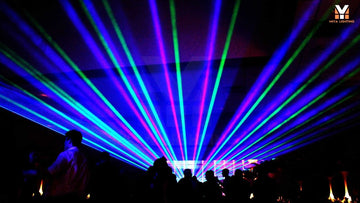All Articles
What Is DMX in Lighting? A Practical Guide for Using DMX LED Par Lights
by MIYA LASERS on Jul 22, 2025

If you’re working with stage or event lighting, chances are you’ve heard of DMX. Maybe you’ve even wondered, what does DMX stand for in lighting or what does DMX mean in lighting? Simply put, DMX stands for Digital Multiplex, and it’s the go-to protocol for controlling stage lighting, including LED DMX lights, lasers, fog machines, and more.
In this guide, we’ll walk you through the basics of what is DMX, how DMX LED lights work, and how to create a simple DMX lighting setup diagram—all in clear, beginner-friendly language.
What Does DMX Stand For Lighting?
DMX stands for Digital Multiplex, and it’s the backbone of modern lighting control systems. It allows one controller to manage multiple light fixtures by sending digital signals through cables—think of it like a “language” your lights understand.
So when someone asks what is DMX? or what does DMX stand for lighting, the answer is: it’s the standard that tells your lights what to do—like change color, dim, strobe, or move.

What Is DMX Used For in Lighting?
DMX is used to control:
- Par LED lights
- LED par lamps
- Moving head lights
- Laser fixtures
- LED walls and screens
- And other DMX light fixtures
DMX gives you precise control over intensity, color, patterns, and timing—perfect for concerts, nightclubs, weddings, houses of worship, or architectural displays.
Wondering what does DMX do? It gives you the freedom to design your lighting however you want, whether that’s subtle ambient lighting or a full-blown synchronized light show.

What Is a DMX Controller for LED Lights?
A DMX controller is what sends the commands to your fixtures. It tells your LED lighting DMX setup how each fixture should behave, whether it’s fading in, flashing blue, or spinning to the beat.
If you’re building your first setup with DMX LED light fixtures, the controller is where everything starts. Assign each light a DMX address, connect the controller, and you’re ready to create magic.
How Do DMX LED Lights Work?
DMX works by assigning each light fixture a starting address (or "channel") in a universe of 512 channels. Using 3-pin or 5-pin XLR cables, the controller sends data signals to each fixture.
Let’s say you have two par LED lights:
- Light A is on Channel 1
- Light B is on Channel 17
Each light might use 4 or more channels to control things like color, brightness, or strobe effect. You connect the controller to the first fixture’s DMX IN, then daisy-chain from its DMX OUT to the next light’s DMX IN. That’s how a DMX lighting setup diagram comes together in real life.
Even though DMX cables look like microphone cables, they’re not the same. Always use true DMX-rated cables for best performance and signal reliability.

New to programming LED DMX lights? Don’t worry—here’s a quick, practical step-by-step:
Collect your gear: A DMX controller, DMX LED lights, XLR cables (at least 100 ft for large spaces)./div>



Assign addresses: Give each fixture a unique DMX channel or address.
Connect the system: Start from controller → DMX IN of Light A → DMX OUT to Light B → and so on.
Power up: Turn on the controller and each light.
Program the controller: Use faders or software to create scenes, color changes, or dimming sequences.
The beauty of DMX is flexibility. You can easily reconfigure lights, update programming, or add fixtures without tearing down the system.

Troubleshooting Common DMX Lighting Issues
Even a well-planned DMX LED setup can run into trouble. Here are quick fixes:
Lights not responding? Check cable connections and power.
Flickering fixtures? Likely a bad DMX cable, wrong addressing, or missing DMX terminator.
Wrong colors or brightness? Check your controller's channel settings or try a reset.
One fixture not working? Double-check its DMX address and make sure it’s set to the right mode.
If you ever ask, what does DMX do in troubleshooting—it’s the signal path and channel logic that you’ll want to verify first.

Choosing the Right DMX LED Light Fixtures
If you want consistent performance, make sure to invest in quality DMX light fixtures and LED par DMX systems from trusted brands. Certified products will offer better color mixing, smoother dimming, and more reliable signal processing.
Whether you’re using LED par lamps for stage wash or LED DMX lights for beam effects, compatibility and build quality matter.

Conclusion: So, What Is DMX Lighting All About?
To sum it up: DMX is the universal language for lighting control. Whether you’re setting up a wedding stage, concert venue, or architectural facade, DMX LED lights let you customize every aspect of your lighting.
From understanding what does DMX mean in lighting to wiring your first DMX lighting setup diagram, this guide gives you the foundation to get started.
Want professional results? Work with certified suppliers and upgrade your system with reliable LED lighting DMX products. Your audience will see—and feel—the difference.
